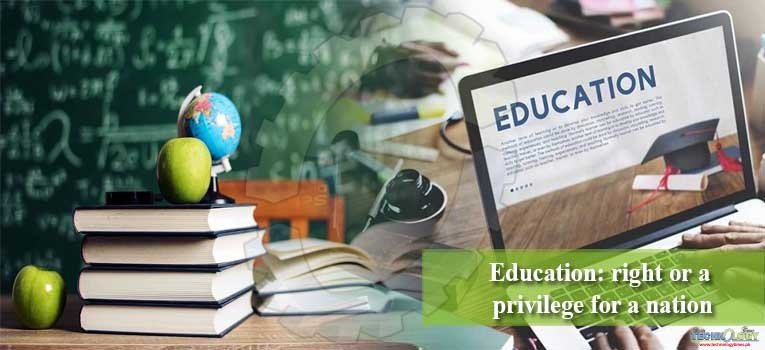The education system of any nation stands as a building block for the era to follow and there is absolutely no doubt about the crucial role an educated population plays is advancing the nation in the expediting world today.
 Pakistan stands as one of the fast-developing nations in Asia, yet the literacy growth stands stagnant over decades, casting one of the lowest literacy rates in the world.
Pakistan stands as one of the fast-developing nations in Asia, yet the literacy growth stands stagnant over decades, casting one of the lowest literacy rates in the world.The constitution of Pakistan necessitates free quality education from the ages 5 to 18 and according to the article 25-A, the state is required by law to facilitate the students of suitable age to their respective educational requirements. However, Pakistan witnesses a monopolistic structure and free education is proximate to a myth in the country.
The country faces a split of numerous boards to cater educational services to the students and the private vs governmental schools is now not the only division faced by students of a growing nation. The governmental schools are subconsciously deemed as schools for the underprivileged and the perception has ingrained a level of inferiority both in the students and the teachers of the schools.
The infrastructure falters accordingly as the educational institutions cast an image of an architectural site with weary walls and an eerie vibe. The private schools have transitioned into a ‘luxury show’ instead of an educational realm where schools continue to push the high society picture into blooming minds to either turn them pretentious or simply put them in a superiority complex.
Not only that but even the board differential and practices seem no longer interested in supporting educational reforms instead continue to push their own brand, each trying to hone their share in the student split of the country.
The nose-diving educational standard of Pakistan varies over regional and gender disposition of the country’s demographic. The urban areas of the country witness literacy rates of over 80% while rages as low as 15% in semi-urban and rural areas. Pakistan stands as second largest in terms of population of school-aged children yet the literacy level projects dismay.
Gender discrimination is another facet to the educational disparity as only 18% of Pakistani women receive substantial education while the enrolment rates are much worse. Even the minority of the female students have staggering attendance records and even the consistent students hardly make it to graduate level.
A prime example is the shortage of female doctors largely due to the demanding nature of the jobs and the lack of relevant educational policies in the sector.
The educational system is now nudged by the private coaching institutes, providing winning scheme instead of knowledge and worldly skills to succeed. The continuing dependence on such institutions is not a minor concern as more than 90% of the students enrolled in private schooling institutions thrive on the notes and lectures provided that should’ve been only a periphery to the entire educational structure.
This sad reality is another reason of the declining enrollment and uneven performance of governmental schools as such hierarchical display of trade of education in terms of admissions, jobs and standard of living it stands obvious that those students won’t climb higher in such a system.
What perplexes a rational mind, however, is that the educational reforms are nowhere to cut such namely facilitators but instead the institutions have started to form a collusion to divide the students amongst themselves to make an even profit whilst putting the future students in the dark.
Only 6% of the county’s population actually target to the post graduate educational levels and the irony to the situation is that the graduates of such tough educational conditions and structure are moulded in the same mindset and instead of correcting the system, 95% of the educated personnel leave the country for good.
In such a vicious cycle of education being traded as a privilege rather than provided as a right, are they really the ones to blame?